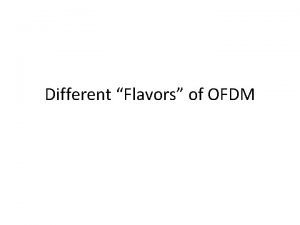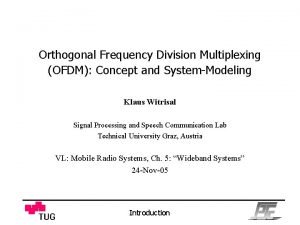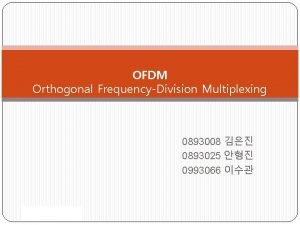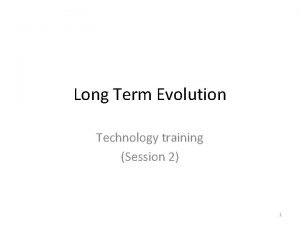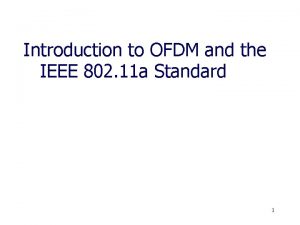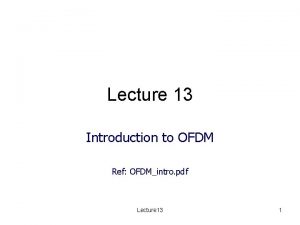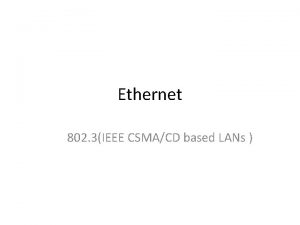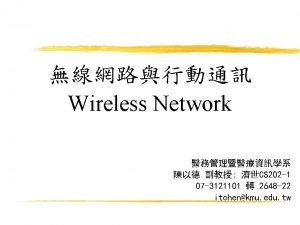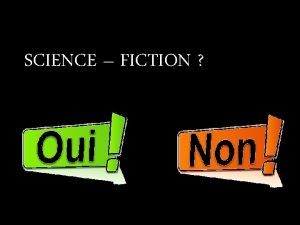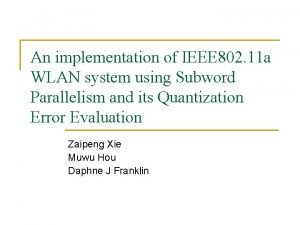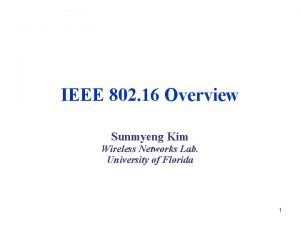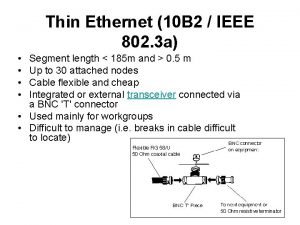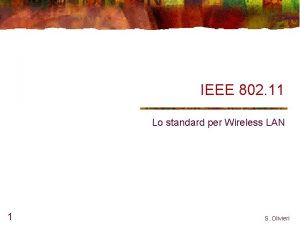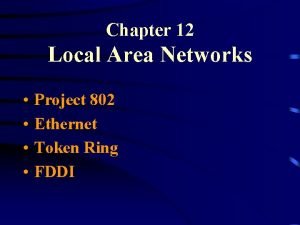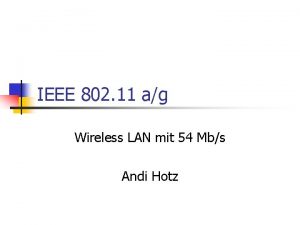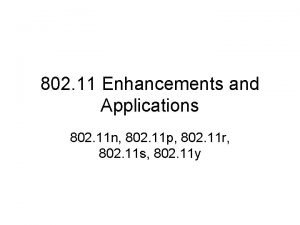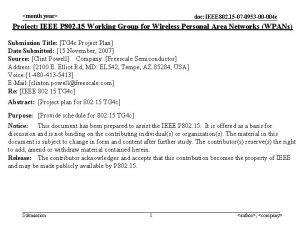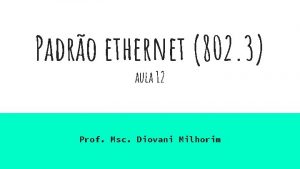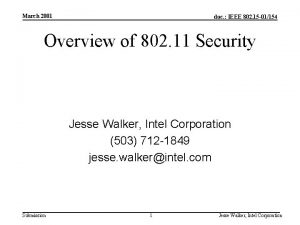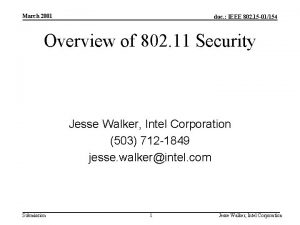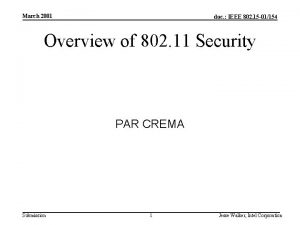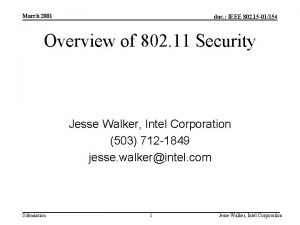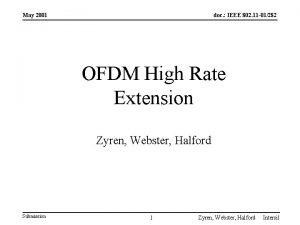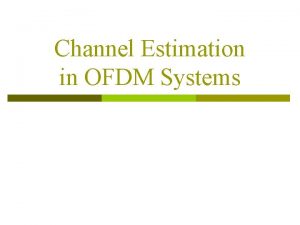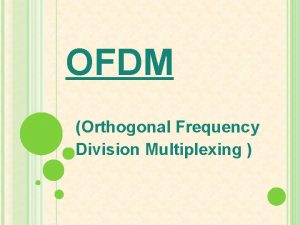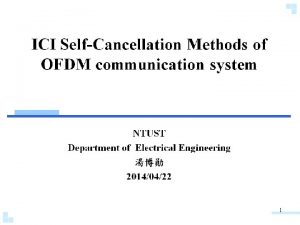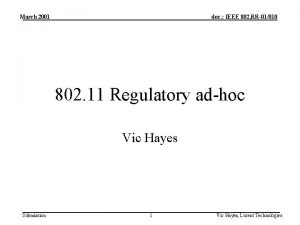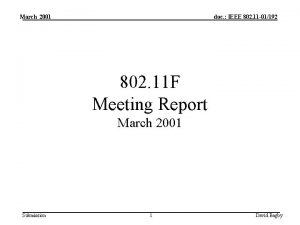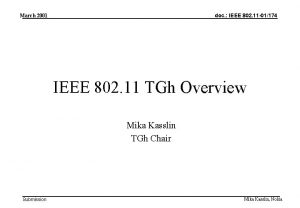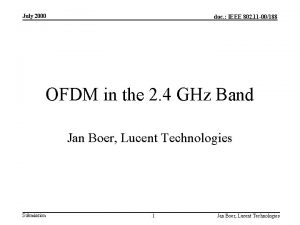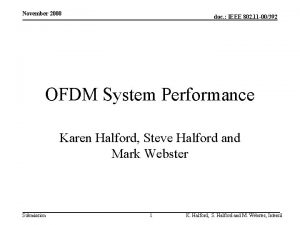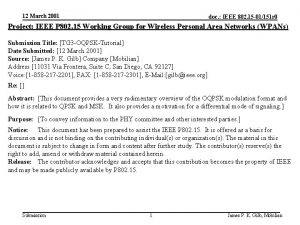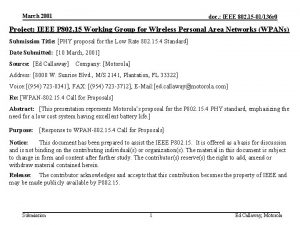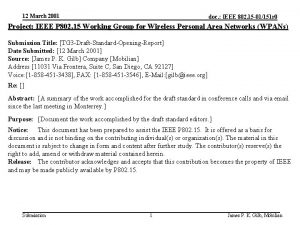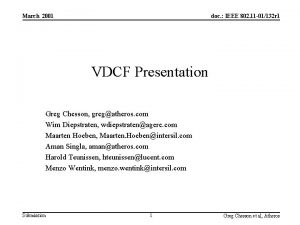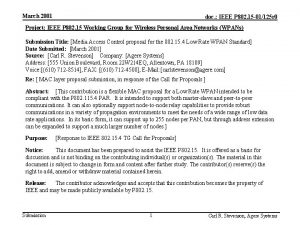March 2001 doc IEEE 802 11 01154 OFDM



































- Slides: 35

March 2001 doc. : IEEE 802. 11 -01/154 OFDM as a High Rate Extension to the CCK-based 802. 11 b Standard Steve Halford, Ph. D. Mark Webster Jim Zyren Intersil Corporation Submission 1 S. Halford, M. Webster, & J. Zyren, Intersil Corporation

March 2001 doc. : IEEE 802. 11 -01/154 Why OFDM for High Rate? • OFDM recognized as best solution for W-LAN üSelected by 802. 11 a & ETSI for W-LAN at 5 GHz • Intersil’s proposed OFDM waveform offers: üFully backwards compatible with 802. 11 b üProvides forward compatibility with 802. 11 a üMeets data rate needs & expectations set by 802. 11 a üBest complexity versus performance trade üGood performance in real world W-LAN üWell-known & proven technology Submission 2 S. Halford, M. Webster, & J. Zyren, Intersil Corporation

March 2001 doc. : IEEE 802. 11 -01/154 Overview of Intersil’s Proposal for 802. 11 g Submission 3 S. Halford, M. Webster, & J. Zyren, Intersil Corporation

March 2001 doc. : IEEE 802. 11 -01/154 OFDM for 2. 4 Ghz band • Use long & short preamble for backward compatibility – Ultra-short preamble possible for certain CCA modes • Replace current CCK data with OFDM – Data modulation identical to 802. 11 a • Maintain the same 2. 4 GHz channels – 25 MHz center frequency spacing (wider than 802. 11 a) • Use 802. 11 a clock rates (20 MHz) for OFDM mode – Data rates identical to 802. 11 a (6, 9, 12, 18, 24, 36, 48, 54 mbps) – Originally proposed using 802. 11 b clock of 22 MHz – Now feel acceptance would be faster with 802. 11 a rates • Technical differences are very small • Rate change circuitry is common in low power IC Submission S. Halford, M. Webster, & J. Zyren, Intersil Corporation – Open to changes from the 4 group

March 2001 doc. : IEEE 802. 11 -01/154 Packet Structure: Backwards Compatible 802. 11 g LONG (Short) Preamble Packets PREAMBLE/HEADER (Barker Words -- 802. 11 b) 192 usecs (Long) 96 usecs (Short) Signal Extension PSDU SELECTABLE OFDM Symbols OFDM SYNC @ 6, 9, 12, 18, 24, 36, 48 or 54 Mbps 12 usecs 6 usecs Uses OFDM Modulation n Existing. 11 b radios will recognize preamble and header § § n n Length field will be correctly decoded Use reserve bits in header to denote switch Add OFDM Sync after. 11 b header to simplify design Add signal extension for SIFS compatibility OFDM Proposal is compatible with 802. 11 b Submission 5 S. Halford, M. Webster, & J. Zyren, Intersil Corporation

March 2001 doc. : IEEE 802. 11 -01/154 OFDM Symbol Structure • OFDM uses industry standard R=1/2, K=7 code – Known performance, complexity, and IP issues • OFDM symbols are formed by IFFT of symbol block – Maps the coded data onto narrow carriers – IFFT block includes 4 pilot/training signals – Carriers retain orthogonality in multipath • OFDM symbols include guard intervals for multipath – Provides “buffer” to absorb ISI Preceding Symbol Multipath will cause preceding symbol to “bleed” into current symbol. Guard interval absorbs this interference Submission Guard Interval 16 Samples 6 4 usecs OFDM Symbol 64 pt. IFFT of coded data 64 Samples time S. Halford, M. Webster, & J. Zyren, Intersil Corporation

March 2001 doc. : IEEE 802. 11 -01/154 Radio Design Issues • Requires a change in baseband processor only – Current RF gives adequate performance up to 36 Mbps • OFDM preserves current channelization – 3 channels spaced by 25 MHz (U. S. deployments) • Power requirements are same as present products • For 48 Mbps & 54 Mbps, new RF design is required – Standard would be in place & spur development – Design issues are well understood Submission 7 S. Halford, M. Webster, & J. Zyren, Intersil Corporation

March 2001 doc. : IEEE 802. 11 -01/154 Performance of OFDM with Prism II Radio Implementation loss due to radio (Loss relative to ideal OFDM performance) 36 Mbps Mode** • 10% PER -- 2. 7 d. B • 1% PER -- 4. 1 d. B 24 Mbps Mode** • 10% PER -- 1. 5 d. B • 1% PER -- 2. 1 d. B Current radio provides sufficient quality to operate at rates up to 36 Mbps ** see notes pages for more details Submission 8 S. Halford, M. Webster, & J. Zyren, Intersil Corporation

March 2001 doc. : IEEE 802. 11 -01/154 Preambles and Throughput Submission 9 S. Halford, M. Webster, & J. Zyren, Intersil Corporation

March 2001 doc. : IEEE 802. 11 -01/154 Throughput Impact of OFDM Sync • Proposed OFDM Sync in addition to 802. 11 b & SIFS pad – Up to 18 usecs of additional overhead – Simplifies the receiver design – Allows future flexibility • What is the impact on throughput? Decrease in throughput 100 byte: 310 kbits/sec 1000 byte: 500 kbits/sec 2346 byte: 704 kbits/sec Throughput impact is negligible Submission 10 S. Halford, M. Webster, & J. Zyren, Intersil Corporation

March 2001 doc. : IEEE 802. 11 -01/154 Complexity and Performance for 802. 11 g Submission 11 S. Halford, M. Webster, & J. Zyren, Intersil Corporation

March 2001 OFDM Transmitter doc. : IEEE 802. 11 -01/154 • OFDM distributes “equalization” between the transmitter & receiver – Single carrier proposals relies on receiver for multipath protection – W-LAN systems are in receive mode 90% of time so reducing receive complexity is critical for power savings • OFDM adds IFFT and cyclic extension operations to Only added items compared to single transmitter carrier system like PBCC – Simplifies the equalizer in the receiver Uncoded Information Bits Data Scrambler Convolutional Encoder Puncture To RF Transmitter Submission Interleave 12 Constellation Mapping (bits to symbols) 64 -pt Inverse FFT Cyclic Extension S. Halford, M. Webster, & J. Zyren, Intersil Corporation

March 2001 doc. : IEEE 802. 11 -01/154 OFDM Receiver Structure • Major difference is use of FFT to simplify equalizer • Reduce tracking complexity with pilot Frequency Domain Equalizer: tones Multiply each tone by inverse gain & Receiver From A-to-D CNCO phase of the channel Timing Adjust Trim Guard Interval FFT &FEQ 52 tones Soft-Decisions on Bits (symbol to bits) Extract 4 Pilot Tones Carrier/Timing Correction Frequency Correction To MAC Submission De-interleave & De-puncture Viterbi Decoder De-Scrambler 13 Compute Branch Matrix S. Halford, M. Webster, & J. Zyren, Intersil Corporation

March 2001 doc. : IEEE 802. 11 -01/154 Error Correction Coding for High Rate • Encoding process is relatively low complexity • Decoding complexity depends on code properties • Decoders are based on Viterbi algorithm • VA searches trellis at each step for most likely state sequence • Complexity depends on the number of states in decoder • Number of states determines size of the trellis searched by VA • PBCC-11 & OFDM use a 64 -state decoder • PBCC-22 uses a 256 -state decoder • Trellis size is 4 x the equivalent all OFDM decoders • Trace-back depth is larger than OFDM-24 OFDM has a less complex error correction code Submission 14 S. Halford, M. Webster, & J. Zyren, Intersil Corporation

March 2001 doc. : IEEE 802. 11 -01/154 PBCC 256 state code vs. Industry Standard 0. 8 d. B Advantage for PBCC-22 at 1% PER 1. 0 d. B Advantage for PBCC-22 at 10% PER 0. 8 -1. 0 d. B Coding Gain relative to punctured industry standard code. Requires Trellix 4 x larger. . . If AWGN performance is needed, better codes could be developed for OFDM Is 1 d. B worth greatly increased complexity? Submission 15 S. Halford, M. Webster, & J. Zyren, Intersil Corporation

March 2001 doc. : IEEE 802. 11 -01/154 Multipath & Equalization for 802. 11 g Submission 16 S. Halford, M. Webster, & J. Zyren, Intersil Corporation

March 2001 doc. : IEEE 802. 11 -01/154 Performance & Complexity Trades • W-LAN performance is dominated by multipath • OFDM is designed for both AWGN and multipath – Error correcting code to provide AWGN – Use guard interval to absorb ISI (0. 96 d. B AWGN loss) – Use pilot tones for improved tracking (0. 34 d. B AWGN loss) • PBCC is optimized for AWGN only – Error correcting for AWGN OFDM is lesscode complex than PBCC – Multipath depends entirely on forperformance W-LAN environment receiver Submission 17 S. Halford, M. Webster, & J. Zyren, Intersil Corporation – Tracking depends entirely on receiver

March 2001 doc. : IEEE 802. 11 -01/154 Equalizers for PBCC • Linear Equalizer -- Invert the channel with linear filter – Length of filter depends on number of multipath rays (15 - 20 taps) – Matrix Inverse required for each packet – More complex than FFT based equalizer for OFDM • Decision Feedback Equalizer (DFE) -- Subtracts interference – Uses hard decisions on received symbols prior to error correction – May need a whitened matched filter (matrix inverse to compute) • Viterbi Equalizer – – Maximum likelihood sequence estimate or MLSE Performance depends on number of paths “tracked” May require whitened matched filter (# of taps ? ) Finds the most likely sequence of transmitted symbol based on channel Neither Linear nor DFE& equalizers make sense for • Similar complexity implementation to decoding a PBCC convolutional code Submission 18 S. Halford, M. Webster, & J. Zyren, Intersil Corporation

March 2001 doc. : IEEE 802. 11 -01/154 MLSE/Viterbi Equalizer Received Data Whitened Matched Filter Viterbi Equalizer Equalized Symbols • Equalizer estimates the most likely sequence based on knowledge of the channel and the received data – Viterbi itself requires only a channel estimate – Matrix inverse may be required for WMF • Can include in Viterbi -- affects the observed channel • Similar to decoding a convolutional code – Searches a trellis for best path between states • MLSE is the likely equalizer for PBCC-11 & 22 – Need to track 4 or more paths for adequate 19 S. Halford, M. Webster, performance & J. Zyren, Intersil Corporation Submission

March 2001 doc. : IEEE 802. 11 -01/154 MLSE: Complexity Considerations • Complexity is similar to convolutional decoder • Number of states depends on constellation and number Numbersize of States in Joint Decoder of multipath rays being tracked Example Track 4 rays for 8 -level PSK (PBCC-22) Number of states = 83 = 512 states Eight times as complex as the 64 state PBCC 11/OFDM decoder& only 4 rays are being tracked! ** See pg. 590, J. G. Proakis, Digital Communication, 3 rd Ed. , Mc. Graw-Hill, 1995. Submission 20 S. Halford, M. Webster, & J. Zyren, Intersil Corporation

March 2001 doc. : IEEE 802. 11 -01/154 Joint Decoder MLSE: Complexity Considerations • Possible to use single “super-trellis” for decoder • Includes both multipath and FEC memory Number of States in Super. Trellis = S ML-1 M: Constellation Size, L: Number of paths tracked, S: number states in FEC Example Track 4 rays for 8 -level PSK with 256 state Conv. Code (PBCC-22 or 33) ü Number of states = 256 x 83 = 217 = 131072 Submission 21 Over 2000 times as complex as the 64 state PBCC-11/OFDM decoder S. Halford, M. Webster, & J. Zyren, Intersil Corporation

March 2001 doc. : IEEE 802. 11 -01/154 OFDM gives MLSE type performance • OFDM uses a guard interval to absorb multipath interference • Outside the guard interval, signal is multipath free – Multipath causes individual tones to fade • After FFT, each tone is multipath free – Relative fade is known from channel estimation • Viterbi Decoder of error correction code gives MLSE in multipath – Reliability of each soft-decision is weighted by known fade – Optimum receiver is realized with only a FFT Submission 22 Halford, M. Webster, & J. Zyren, Intersil Corporation – True provided multipath is S. entirely inside guard

March 2001 doc. : IEEE 802. 11 -01/154 OFDM: MLSE performance w/o complexity OFDM Multipath Tolerance • OFDM proposal includes 800 n. Secs Guard Interval • Equivalent to 800 e-9 x 11 e 6 = 8. 8 paths at PBCC symbol rate • Multipath tolerance equivalent to tracking 8 paths • FFT complexity is approximately twice the complexity of a 64 state decoder Equivalent SC MLSE Complexity This is 215 (over 32, 000) times the complexity of the 64 state decoder! Submission 23 S. Halford, M. Webster, & J. Zyren, Intersil Corporation

March 2001 doc. : IEEE 802. 11 -01/154 Impact of interference on 802. 11 g Submission 24 S. Halford, M. Webster, & J. Zyren, Intersil Corporation

March 2001 doc. : IEEE 802. 11 -01/154 Interference in 2. 4 GHz band • 2. 4 GHz spectrum is a shared resource – Blue. Tooth & other FH systems generate in-band interference on 802. 11 b & 802. 11 g radios – Other sources of interference include microwave ovens • Higher data rates specified by 802. 11 g will be more sensitive to interference – Errors generated by presence of interference source can greatly influence throughput • Blue. Tooth enabled devices will proliferate at same time as 802. 11 g PBCC is sensitive to real world interference sources Submission 25 S. Halford, M. Webster, & J. Zyren, Intersil Corporation

March 2001 doc. : IEEE 802. 11 -01/154 PBCC performance is sensitive to Blue. Tooth E. Zehavi, et al (IEEE documents IEEE 802. 1101/061 r 0 & IEEE 802. 15 -01/066 r 0) showed that the throughput of coded 8 -PSK w/o an interleaver was very sensitive to the presence of a Blue. Tooth- like interferer. Submission 26 S. Halford, M. Webster, & J. Zyren, Intersil Corporation

March 2001 doc. : IEEE 802. 11 -01/154 Extending PBCC to higher rates (>22 Mbps) Submission 27 S. Halford, M. Webster, & J. Zyren, Intersil Corporation

March 2001 doc. : IEEE 802. 11 -01/154 Approaches to Higher Data Rates • OFDM provides a known path to higher rates • Higher data rates can be achieved by: – Increasing the constellation size and/or decrease code rate • Used by OFDM to give rates of 6 Mbps to 54 Mbps • PBCC-22 uses 8 -psk with rate 2/3 code to go from 11 Mbps (QPSK with rate 1/2) to 22 Mbps – Increasing symbol rate • PBCC-33 uses 1. 5 x clock speed to go from 22 Mbps to 33 Mbps • Increasing the data rate increases the required SNR OFDM equalizer complexity is same for all rates -What is the impact on the PBCC receiver? Submission 28 S. Halford, M. Webster, & J. Zyren, Intersil Corporation

March 2001 doc. : IEEE 802. 11 -01/154 Are Higher Data Rates Possible? • OFDM Equalizer has fixed complexity for all proposed rates – Higher rates does impact performance due to fading of tones • Guard interval however reduces the impact independent of rate • MLSE complexity will grow exponentially when constellation size increases – Higher rates will impact performance • No guard interval to protect from increased ISI sensitivity – Example: Track 4 paths -- Number of states = (constellation size)4 -1 • 22 Mbps (8 -PSK) requires 83 = 512 states (8 x the PBCC-11 decoder) 3 = 4096 states Extending to higher constellation • 33 PBCC Mbps (16 -QAM) will rates requireby 16 increasing (64 x the PBCC-11 decoder) is not practical • 44 Mbps (64 -QAM) will require 643 = 262144 states (4096 x the Submission 29 S. Halford, M. Webster, & J. Zyren, Intersil Corporation PBCC-11 decoder)

March 2001 doc. : IEEE 802. 11 -01/154 Are Higher Data Rates Possible? • OFDM uses a fixed symbol rate for all data rates – Guard interval protection is same for all rates • PBCC-33 is PBCC-22 at a higher symbol rate – Pulse shaping used to keep same spectral width • Increasing symbol rate impacts performance – Increasing timing accuracy requirements • Increasing rate increase number of equalizer paths – Example: 8 -PSK -- Number of states = 8(number of paths -1) • 22 Mbps (11 Mhz, 4 paths) -- 84 -1 = 512 states (8 x the PBCC-11 decoder) Extending PBCC to higher increasing • 33 Mbps (16. 5 Mhz, 6 paths) rates -- 86 -1 = by 32, 768 states (512 xsymbol PBCC-11 rate decoder) is not practical states PBCC-11 Submission • 44 Mbps (22 Mhz, 8 paths) -- 88 -1 30 = 2, 097, 152 S. Halford, M. Webster, (32, 768 x & J. Zyren, Intersil Corporation

March 2001 doc. : IEEE 802. 11 -01/154 Conclusions on OFDM for 802. 11 g Submission 31 S. Halford, M. Webster, & J. Zyren, Intersil Corporation

March 2001 doc. : IEEE 802. 11 -01/154 Summary of Data Rates & Parameters Submission 32 S. Halford, M. Webster, & J. Zyren, Intersil Corporation

March 2001 Conclusions doc. : IEEE 802. 11 -01/154 • OFDM is forward & backwards compatible – Uses existing long & short preamble for compatibility’ – 802. 11 a signaling used in place of CCK – Minor impact on throughput of added headers • OFDM offers the highest rates of all proposals – 36 Mpbs with current radio (baseband only change) – 48 & 54 Mbps possible with new radio design – PBCC complexity grows exponentially Submission 33 S. Halford, M. Webster, & J. Zyren, Intersil Corporation

March 2001 Conclusions doc. : IEEE 802. 11 -01/154 OFDM is ideal for W-LAN environment – Equalization split between transmitter & receiver for lower overall complexity – Lower complexity error correction code – Nearly MLSE without complexity – PBCC Joint Decoder approach requires RSSE • Complexity vs. Performance ? OFDM is robust to narrowband interference – PBCC seems to have an inherent problem with BT Submission 34 S. Halford, M. Webster, & J. Zyren, Intersil Corporation

March 2001 Conclusions doc. : IEEE 802. 11 -01/154 OFDM will meet regulatory approval – All high rate waveforms possible under new rules (? ) – OFDM will be in this band -- IEEE should ensure network compatibility • OFDM has been developed in an open process – No hidden details – Complexity of PBCC never adequately described – Complexity and design is well known & proven Submission 35 S. Halford, M. Webster, & J. Zyren, Intersil Corporation
 Bridges from 802.x to 802.y
Bridges from 802.x to 802.y Bridges from 802.x to 802.y
Bridges from 802.x to 802.y Poland national anthem lyrics
Poland national anthem lyrics Ieee 802 3 compliance
Ieee 802 3 compliance Ieee 802
Ieee 802 Arquitetura ieee 802
Arquitetura ieee 802 Estandares ieee 802
Estandares ieee 802 Ieee 802 standard
Ieee 802 standard Bluetooth ieee 802
Bluetooth ieee 802 802 ieee
802 ieee Ieee 802
Ieee 802 Ieee 802 family
Ieee 802 family Guard interval in ofdm
Guard interval in ofdm Ofdm full form
Ofdm full form Matlab ofdm
Matlab ofdm Ofdm 원리
Ofdm 원리 Ofdm scheme
Ofdm scheme Long term evolution advanced
Long term evolution advanced Ofdm symbol
Ofdm symbol Introduction to ofdm
Introduction to ofdm Ethernet 802
Ethernet 802 802 family
802 family Lan 701
Lan 701 Sybex ccna
Sybex ccna Wlan 802
Wlan 802 Ssin-802
Ssin-802 802-3-ethernet
802-3-ethernet 802/11
802/11 Ssin-802
Ssin-802 Project 802
Project 802 Wireless lan 802
Wireless lan 802 Mac address
Mac address 802 11 n
802 11 n 802 15
802 15 507-802-380
507-802-380 802 3
802 3












